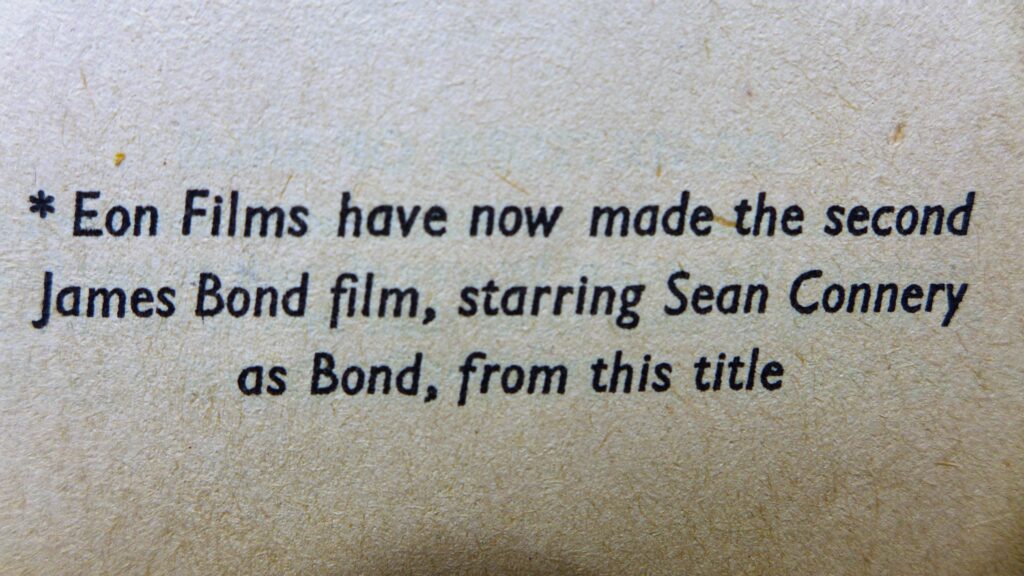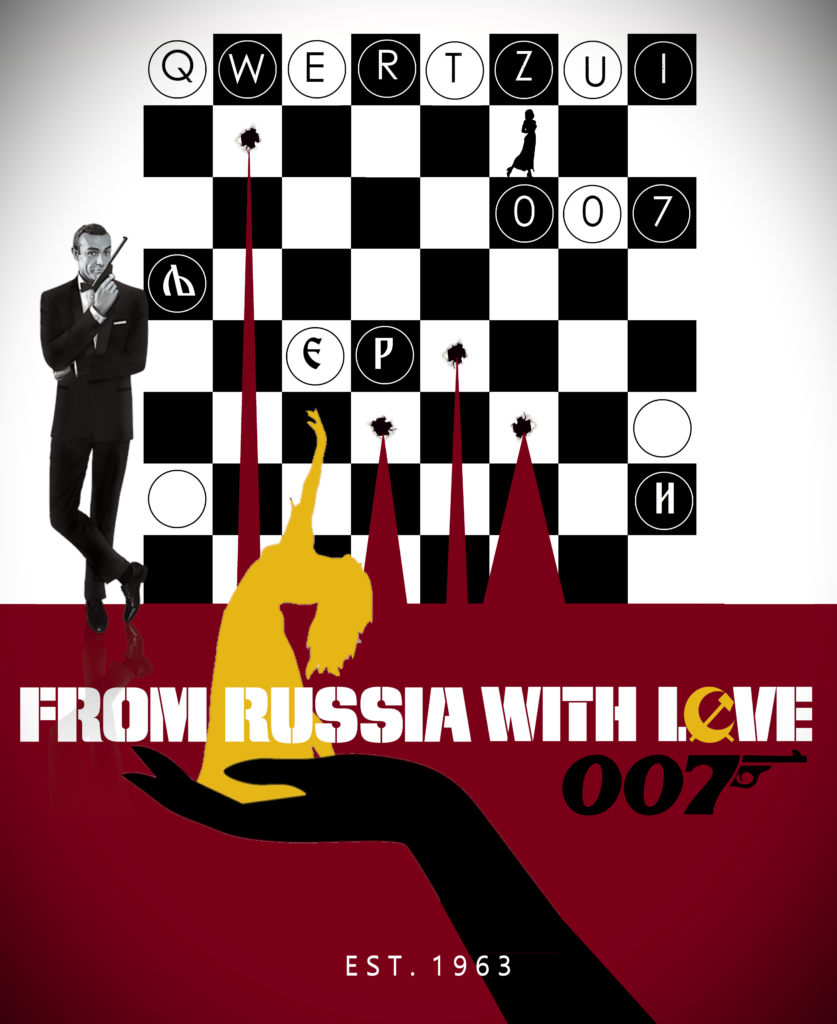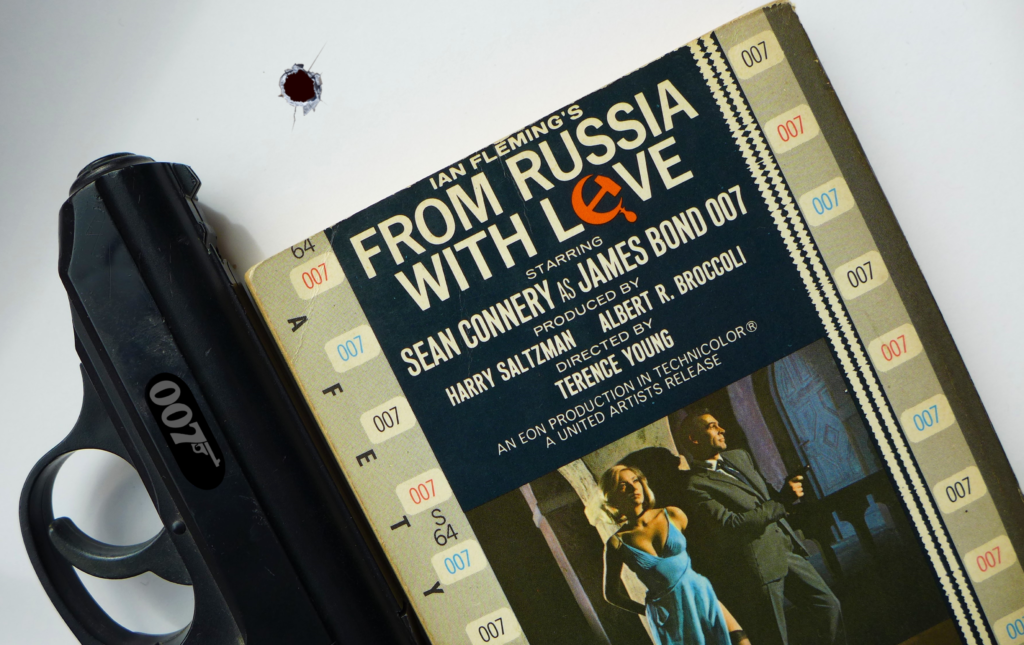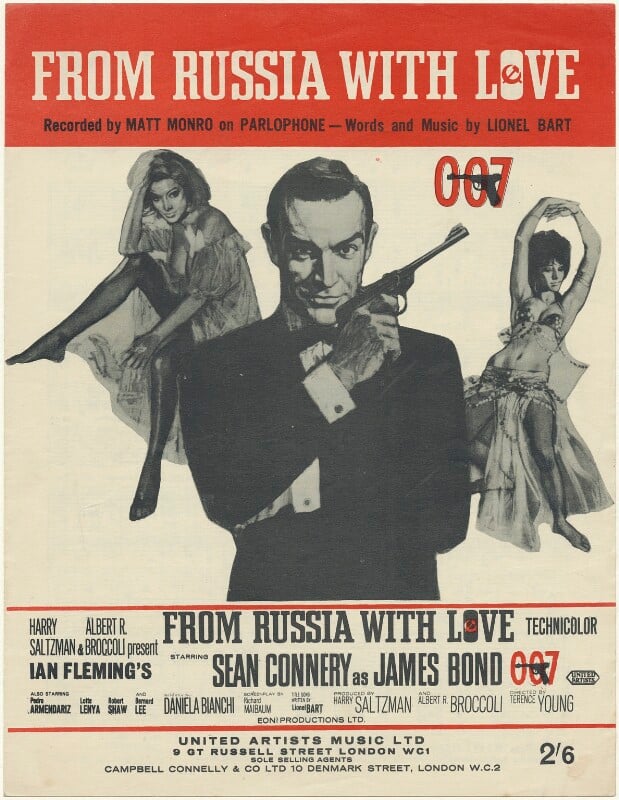“We always start out trying to make another From Russia with Love and end up with another Thunderball.’
Michael g. wilson, bond producer

The first Bond bullet to remain more faithful to its source novel. The first Bond movie to yield a pop-era title tune. The first Bond film to use silhouetted sensuality as a graphical overture. The first to be premiered at London’s Odeon Leicester Square. And the last Bond role Sean Connery played.
On October 10th 1963, EON Productions fired their second Bond opus From Russia with Love at the world. It is the leading 007 masterpiece whose Cold War cadence, espionage characterization and literary spine inform movie Bond until this day. Such is the impact of director Terence Young’s second spin of the 007 movie dice, that Bond ’63 is a barometer for new Bond actors, actresses and directors. If any actor is in the crosshairs of EON’s casting eye, it is the almost non-descript seduction scene between leading man Sean Connery and Daniela Bianchi (Tatiana Romanova). Many an otherwise totally appropriate Bond contender has fallen at such a task. Available screentests of unsuccessful candidates prove the invisible subtly the scene requires for either role. It is a precision moment. And one no doubt heard around Bond HQ in current times as a 007th actor has to pass the 1963 test.
‘We always use the same scene, and that’s the one in From Russia with Love, where Bond comes back to his room after the assassination, and he starts taking off his shirt, goes into the room to bathe. Then he hears something, takes his gun, goes in and the girl is in the bed,’ Wilson told the audience. That is the test we use. Anyone who can bring that scene off is right for Bond. It’s tough to do.’
michael g. wilson, bond producer / september 2022
The previous and starting pistol moment that was 1962’s Dr. No walks in the literal footsteps of author Ian Fleming and his Jamaican writing world. It plays like a Bond film on holiday. Its spur and dramatic impetus stems from where Fleming would go to unwind as an author. EON Productions’ From Russia With Love feels informed by where he went to work as a spy. If Dr. No is Fleming’s beaches, calypso bars and Jamaican seascapes, From Russia is Fleming’s Europe, shadowy basilicas, private bureaus and crosswire politics. Many Bond films unfurl themselves in the social, after-work hours. From Russia With Love is pinned to the nine-to-five minutiae of spying – or the nine-to-five minutiae of cinematic spying.
‘In 1963 the Bond series was not a series yet. From Russia With Love was merely a sequel, a follow-up. There were obviously plans afoot to film more adaptations of Ian Fleming’s extensively optioned spy works. The first four 007 movies came out barely a year apart demonstrates a certain production and commercial conviction at United Artists and Eon Productions. Broccoli and Saltzman knew more than anyone that this is show business. Nothing is assured. Their masterstroke was how they created an entirely new genre. The spy adventure movie had been done before. But not like this. Stood alongside each other, the first three Bond films form a sort of Darwinian evolution of the 007 genre. Sean Connery is not quite ape-like but certainly standing ever tall within an Ascent Of James timeline as determined by the natural selection of directors Terence Young and Guy Hamilton, producers Harry Saltzman and Cubby Broccoli, stunt coordinator Bob Simmons, production designers Ken Adam and Syd Cain, photographer Ted Moore, writers Richard Maibaum and Johanna Harwood, editor Peter Hunt and tunesmith John Barry.’
‘From russia with love’, catching bullets
The skill of From Russia With Love is that it does not need the ever-burgeoning Bond movie canon around it to prop it up. Being upfront in the pecking-order helps. However, it is extremely proficient on its own footings, with an individual through-line of logic, intent and cynicism. The events of Dr. No are alluded to, but the momentum of the Bond machine is not there yet.
The upshot is this bullet has less complacency and sense of procedure about it. It is easily one of the DNA blueprints of 007. It is mostly all here – the pre-title sequence, a reverberating title song, a city view of Europe as seen through its granite pavements and side-streets, the dual denouement, the bespoke trimmings and a villain sporadically featured from the start. If these essentials are not fully established in Dr. No, they are certainly delivered in this second Bond as the boxes on the Broccoli/Saltzman periodic table are hurriedly filled with the critical elements of ‘007’.
Some of From Russia’s plot-dressing and story curvatures are rarely found elsewhere in the series. Consider the film’s distinct lack of action. Or rather, reliance on it. It has its moments, but they are a grammar to the story – not the other way round.
The white paint has barely dried on those From Russia gun-barrel dots as they drop us for the first time ever at the tail-end of some other Bond film that doesn’t really exist. That is a great device of the Bond films – overturing themselves with themselves.
It makes sense the debut of this ruse lands us in 007’s production home and some Pinewood mansion, come Russian agent training-camp. And as Robert Shaw and the not-Sean Connery stalk each other through the hedges of Pinewood’s Heatherden Hall, a cinema owner’s son from York starts stalking the pair of them with a new musicality instantly more potent and creative than any SPECTRE zipwire-watch. When John Prendergast Barry makes his 007 debut proper in From Russia With Love, he is already ahead of the Cold War. He is already ahead of James Bond. Within ten minutes of screen time, his From Russia With Love score is that Bond sound before That Bond Sound was a common, expected parlance.
And it is not The James Bond Theme over the gunbarrel motif that slaps the audience to attention. It is the opening crashes of the From Russia With Love theme tune – fired like a machine gun at the audience before Barry serves up a sensuous “look, don’t touch”milieu to Robert Brownjohn’s lap-dancing titles.
That is where that Bond sound makes its’ entrance at the hands of Barry. That is where “James Bond” is carved forever more on the tree of modern cinema. And that is where From Russia With Love gives the series the aural silhouette of wit, sex and risk it has hunkered alongside ever since.





